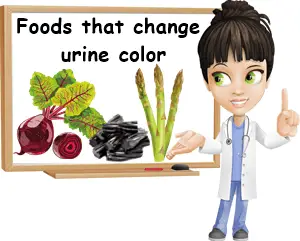Just like there are foods that color your tongue red, purple, blue, green or even black, there are also foods that color your urine. Technically, any food that contains a strong enough dye can change the color of your urine, and possibly also color your stools, stain skin and clothes. Few natural, un-processed foods contain pigments so strong they can change the color of urine, whereas a lot of processed food choices contain strong enough pigments that dye urine different colors. Among the foods that change urine color, red beetroot, rhubarb, asparagus and blackberries rank as the most likely to do so.
What is normal urine color?
You’ll hear it everywhere that normal urine color is straw-yellow. That is, a somewhat light or pale yellow color. If you tend to drink lots of liquids, it may be a really pale yellow or almost transparent; if there is barely any color visible, then it’s usually a sign you might be drinking more fluids that you need to. Medium or darker yellow or amber-colored urine is usually a symptom of dehydration and warrants upping water intake. So depending on how hydrated you are, normal urine color should be a lighter shade of yellow.

What changes urine color?
Any change in urine color straying from – preferably light – yellow is not in the normal range and can be caused by dietary choices, medications, various medical therapies, conditions or disease. For the most part, temporary changes in urine color are a result of eating or drinking strongly pigmented food products and should resolve on their own soon after said food products are excluded from the diet. For urine color changes that persist beyond a few hours or a couple of days, it is recommended to see a doctor for tests.
What foods color urine?
It is important to understand that not all foods known to change urine color affect everyone the same way. There are multiple factors at play that determine the occurrence of unusual or abnormal colors in urine, including the quantity of strongly pigmented foods taken in and having low stomach acidity which means a reduced ability to break down components in food, including pigments. As a result, some people may not be affected at all by eating foods known to change urine, whereas others may exhibit changes in urine color every time they eat or drink certain food products. The foods: what are they?
Red beetroot and red beet juice
One of the foods most likely to color urine is beetroot. Red beetroot and red beetroot juice contain a strong natural purple-red pigment called betanin (a type of betalain pigment specific to beets). This pigment is so strong that it can sometimes survive stomach acid intact, coloring both urine and stools on its way out of the body. Red beets are one of those foods that can color urine red, but also red-purple, pink and even brown, depending on both intake and how the pigment in beets is metabolized by the person.
The pigments in red beet, notably betanin, but also other betacyanin betalains, are extracted and widely used as a natural food dye for a wide range of food products. For example: red and purple fruit juices (carrot juice, red and black carrot juice, orange juice, red orange juice, tomato juice etc.), tomato paste and ketchup, canned tomato soup, red gelatin, red and purple candy, ice-cream, icing, sweet fillings for baked goods as well as specialty cheeses and cold meats (sausages, bacon, salami etc.). Eliminating pink, red, red-purple or even brownish urine as a result of consumption of raw, cooked or pickled red beets, red beet juice or foods enhanced with red beet extract or pigments is known as beeturia and is a harmless, temporary, self-resolving condition.

Golden beetroot
Golden beetroot varieties contain a different type of betalain pigment, namely betaxanthins. Betaxanthins are yellow-orange pigments, as opposed to betacyanins such as betanin in red beets which are red and purple. Given the right conditions, eating enough golden beets can cause urine color to change to orange. Factors such as having low stomach acid production or eating foods high in oxalates such as sorrel, spinach, chard or beet greens help protect the pigment and cause it to be eliminated in urine, producing the change in color. Find out other causes of orange urine in the article urine colors and what they mean.
Rhubarb
Eating rhubarb has been shown to cause pink, reddish or sometimes brown urine colors. The change in urine color is a result of the natural pigments in the edible stalks which survive digestion in the stomach. Rhubarb stalks also contain small amounts of oxalic acid which is said to help protect the pigment from digestive juices and contribute to the change in urine color.
Asparagus
There are many benefits to eating asparagus, such as promoting good vision and healthy skin and mucous membranes as a result of a great vitamin A content and supporting blood clotting and preventing nosebleeds and easy bruising as a result of an excellent vitamin K content. The vegetable is further rich in B vitamins and dietary minerals such as copper. But eating asparagus changes urine color, turning it slightly green. Not only this, but also changes urine odor, promoting a foul, ammonia-like smell. While carotene pigments and chlorophyll are responsible for the green urine color, naturally-occurring sulfur compounds cause the bad urine smell after eating asparagus.
Carrots and carrot juice
Carrots are sweet-tasting root vegetables known for their beautiful bright colors. Most carrots consumed nowadays are bright orange, but yellow, red, purple and dark purple-blue or black carrots are also becoming largely available to consumers. All of these beautiful bright colors are a result of impressive amounts of antioxidant carotenoid, lycopene and anthocyanin pigments – carotenoids for yellow, orange and red carrots, lycopene for mostly red carrots and anthocyanins for purple and dark purple carrots. Eating sufficient amounts of carrots or drinking enough carrot juice can promote changes in urine color. For example, orange carrots can cause orange urine color. Red and purple carrots can cause pink and reddish urine. Also, purple and dark purple-blue or black carrots and foods dyed with black carrot extract can cause dark urine in some people. Also see the benefits of black carrots.
Blackberries
Most people eat blackberries and simply feel good about themselves and having made a delicious and healthy food choice. But some people eat blackberries and get dark-colored urine. What changes urine color to a darker, reddish or purplish or even brownish shade is the anthocyanin content of the fruit. Anthocyanins are strong antioxidant pigments responsible for red, purple, blue and black colors in fruits, leaves and flowers. If, for some reason, these pigments are not metabolized correctly or completely, changes to normal urine color may occur in some people. Fruits that are almost black in color, such as blackberries, chokeberries or aronia berries, black raspberries and black mulberries, are especially rich in these natural pigments and more likely to cause such variations in urine color.
Black licorice
Having black licorice, usually too much of it too frequently, can change color in both your stools and urine. Black licorice is known to make stools dark green or almost black. And it can also cause urine color to temporarily become dark. Depending on how much black licorice you’ve had and how frequently, the change in urine color can be more or less noticeable, but should nevertheless be temporary (typically last a couple of days tops). Also see what foods color stools.
Fava beans
Do fava beans change urine color? In some people, yes, they do. But fava beans are somewhat of a particular food anyway. Glucose-6-phosphate dehydrogenase deficiency, G6PDD for short or favism, is an inherited condition that creates a predisposition for red blood cells to break down. Upon breaking down, red blood cells release their contents into the blood and ultimately into urine, resulting in dark-colored urine, a sign of the presence of blood. In those with favism, eating fava beans triggers a chain of events that leads to blood in the urine and more serious complications. So if you notice a darker color to your urine and can remember eating fava beans recently, it’s a good idea to see your doctor.
Conclusion
If you notice a different color to your urine, don’t go into panic mode right away. Instead, try to remember what you ate or drank in the past couple of days and see if you can connect your dietary choices to the change in urine color. In addition to food, it’s important to consider any medication you might be taking or treatment for existing conditions as these too can be a source of changes in urine color. Most important, remember that the changes are supposed to be temporary and last a few hours to a couple of days, provided you discontinue what you think may be the source of the new colors. But if you can’t connect a strange color to anything you recently ate or drank, especially if the color may indicate the presence of blood (red or brown), then it’s a good idea to see your healthcare provider right away for some tests.
